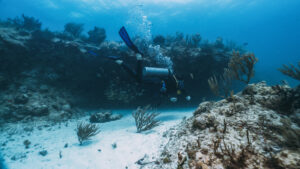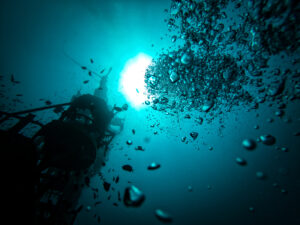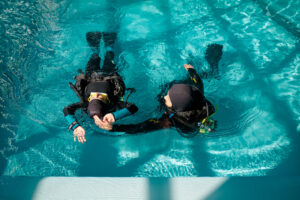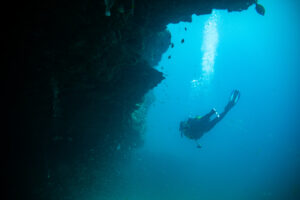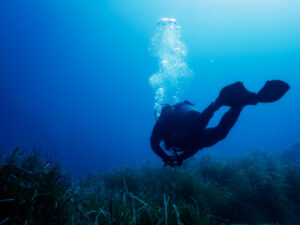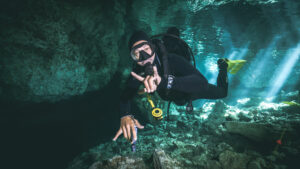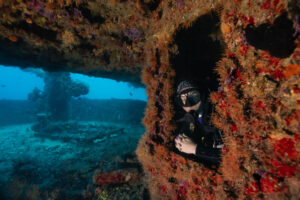What is a Swim Thru?
A swim thru is a noteworthy term in the realm of scuba diving, referring to a short underwater tunnel or opening that divers navigate through during their subaqueous explorations. It can be a natural feature like an opening in a coral reef or a rock formation, or an artificial feature such as a wrecked ship’s hold. Technically, a swim thru is classified as an overhead environment, despite often being too short to fully warrant this categorization.
Nature of Swim Thrus
As a unique feature of the underwater terrain, swim thrus can significantly enhance the adventure and thrill of a dive. They provide divers with an opportunity to experience the fascinating and complex geology of the ocean floor firsthand. Swim thrus can range in size from small openings just large enough for a diver to pass through, to large underwater tunnels that can accommodate multiple divers at once. The length, width, and depth of swim thrus can vary greatly, and they can be found in diverse diving locations around the world.
Interaction with Marine Life
Swim thrus also provide divers with a unique vantage point for observing marine life. Many species of fish and other sea creatures use these natural structures as a refuge or breeding grounds. Thus, divers can often observe unique behaviors and interactions that are not typically visible in more open water environments. From colorful reef fish darting in and out of a coral tunnel to the elusive octopus hiding in the crevices of a rock swim thru, the opportunities for marine life observation are abundant.
Technical Aspects and Safety
Although the term ‘swim thru’ implies a brief, uncomplicated part of a dive, there are technical considerations that divers must be aware of to ensure a safe and enjoyable experience. Because a swim thru involves an overhead environment, even if short, divers must be mindful of their buoyancy control to avoid collision with the top or bottom of the structure. Careful navigation is required to protect both the diver and the delicate underwater ecosystem.
In terms of gear, a diver’s equipment configuration might need to be streamlined to prevent snagging or damaging the environment. For instance, long gauges or dangling accessories should be secured. Lighting is another important consideration. Even though a swim thru is typically short, it can be dark, requiring the use of a dive light.
Training and Experience
As swim thrus present unique challenges and potential hazards, proper training and experience are crucial. Some divers may find confined spaces and overhead environments intimidating or claustrophobic, requiring mental preparation and stress management training.
There are specialized courses, like the PADI Cavern Diver or TDI Intro to Tech, that offer training for overhead environments, providing divers with the skills necessary to safely navigate swim thrus. These courses cover areas such as line-laying and reel use, gas management, specific buoyancy control techniques, emergency procedures, and specialized equipment use.
Swim Thru vs. Cave Diving
While swim thrus and caves may seem similar, they are quite distinct in terms of scuba diving. Cave diving refers to diving in underwater caves with no direct, vertical access to the surface. It is considered a type of technical diving due to the advanced training, equipment, and precautions required.
On the other hand, swim thrus are typically shorter, with an exit point always in sight. Thus, they are more accessible to recreational divers and do not necessarily require the extensive training and equipment that cave diving does. However, this does not negate the need for caution and respect for the environment when navigating a swim thru.
Key Takeaways
Swim thrus are unique features of the underwater landscape that offer divers a thrilling and immersive diving experience. They provide opportunities for close-up interaction with marine life and firsthand exploration of the ocean’s geological formations. However, they are also environments that require special consideration and respect.
While the term ‘swim thru’ may suggest a simple and brief part of the dive, the reality is that it involves careful navigation and proper control of buoyancy. It is essential for divers to be mindful of their actions to ensure their own safety and to protect the fragile ecosystems that they are privileged to explore.
Specialized training courses are recommended for those who wish to make swim thrus a regular part of their diving adventures. These courses equip divers with the necessary skills and knowledge to navigate these environments safely and responsibly.
Moreover, despite some similarities, it is crucial to distinguish between swim thrus and cave diving. The latter requires a higher level of expertise and more specialized equipment due to the inherent risks and challenges involved. Swim thrus, on the other hand, are generally more accessible to recreational divers.
Swim thrus are short underwater tunnels or openings that divers pass through during their dives. They offer an exciting and unique aspect of the underwater world that divers can enjoy. However, they are not without their challenges and potential hazards. With proper training, equipment, and respect for the environment, divers can safely and responsibly enjoy the unique experience that swim thrus provide.
By recognizing and respecting the inherent challenges and beauty of swim thrus, divers can enrich their underwater experiences while contributing to the preservation of these unique environments for future generations of divers to enjoy. These underwater features offer a glimpse into the ocean’s depths that few people get to experience, making them a cherished aspect of the scuba diving adventure.



